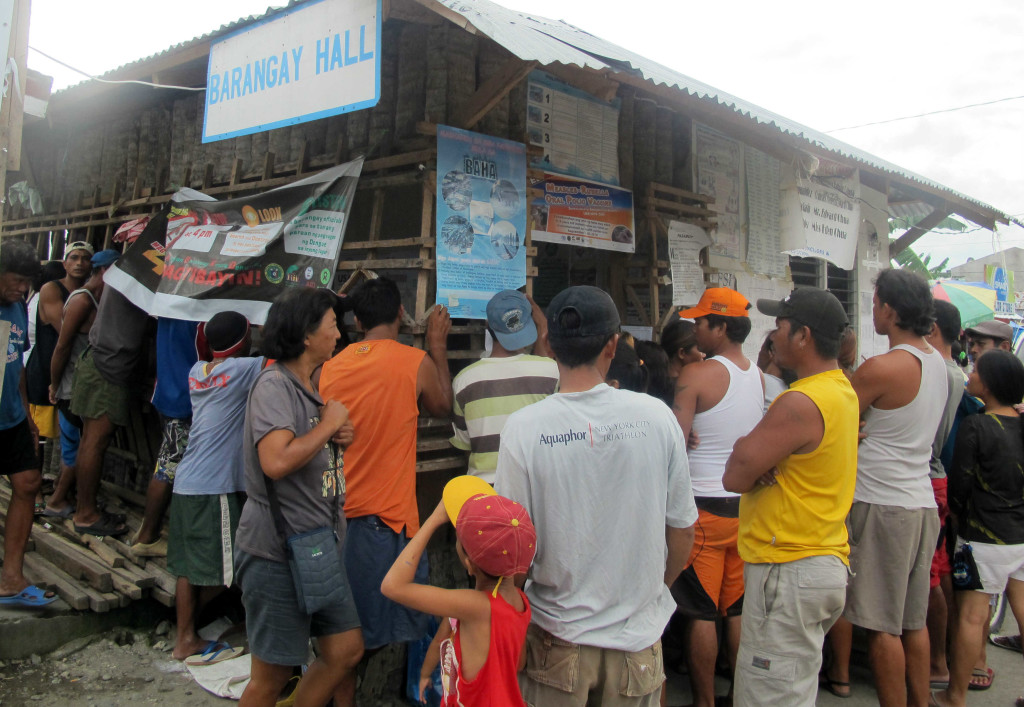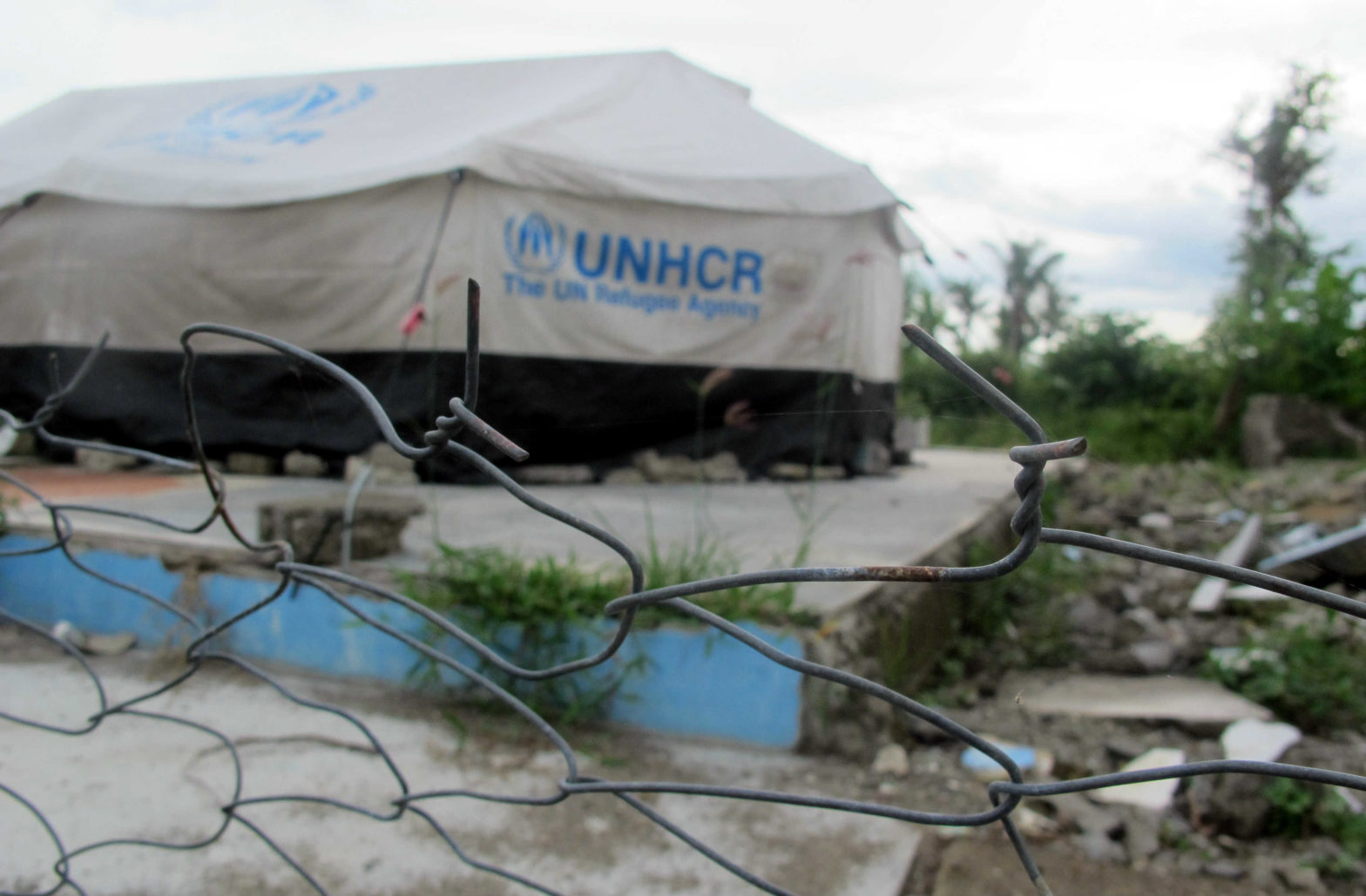
By AVIGAIL OLARTE
TACLOBAN CITY—Inside the white, family-sized tent, Delia Capangan stood in the middle of what she now calls home sweating. It was mid-afternoon, but the heat clung to the skin, raw and burning.
Capangan, 61, is one of more than 2,000 people still living in tents here. Strewn about her were pieces of clothing, pillows and blankets, and on the floor pots and forks, slippers, a clump of firewood.
By the seaside, in Barangay 88 where she lives, about 330 families remain suffering, lumped in donated, already damaged tents. During the rain, her roof leaks and her floor is flushed with water.
“I’ve heard of the temporary shelters, but we’ve been here for months and no one has asked us to move,” the mother of four said, pointing to the coconut tree that saved their lives when sea waves struck, hurling them away in its fury.
Barangay 88, the biggest barangay in Tacloban in size and population (10,646), recorded the highest number of casualties, at over 1,000, when “Yolanda” battered central Philippines.
It has been 10 months since the supertyphoon struck, and one question nags Capangan, along with hundreds others: Where are the billions of pesos for Yolanda victims?
As of September, the country has reportedly gotten P71 billion worth of foreign aid pledges in cash and in kind; only P15 billion has been received.
“The recovery is so slow because there’s no help from the national government. Ni milyon di namin naramdaman. Ang mga tao hirap na hirap na (We haven’t seen even millions. The people are suffering),” Barangay 88 captain Emelita Montalban said.
A Commission on Audit report showed that as of last Dec. 31, P782 million in local and foreign donations remain unutilized, deposited in bank accounts of the Department of Social Welfare and Development.
A portion of that money is for shelters, for families like Capangan’s.
On Sept. 9, DSWD Secretary Corazon “Dinky” Soliman said that by end of September, no family in all Yolanda areas will be living in a tent. All of them, she said, will be moved to temporary shelters.
How the national government intends to do this, along with the local governments, remains unclear.
In Tacloban, the city government has set its own target. End of November is when Mayor Alfred Romualdez said he would have over 800 families out of the tents. He said along with international nongovernment organizations, the city government is targeting a thousand temporary shelters, costing P45,000 each, in a month or two.
“They’re desperate to get out already. I promised them that if they go to temporary shelters, a permanent shelter is on its way,” he said, referring to the tent dwellers.
But he also said he needs more funds. The city government has used up all of its calamity funds, and taxes from local businesses are barely coming in.
“The local government is broke. We do not have the money to purchase land. If not for Operation Blessing, Operation Compassion, the Catholic Relief Services and other groups, I wouldn’t be able to transfer the people,” Romualdez said.
Data from the 2014 Tacloban Recovery and Rehabilitation Plan show that 10,000 of the houses totally damaged belong to the poor. A total of 14,433 of these houses were in the danger zones of 31 hard-hit coastal barangays. Of this, 12,231 houses were destroyed and 2,202 partially damaged.
Along with the temporary shelters, the local government is targeting completion of 10,000 permanent houses, each costing over P200,000 in the northern part of the city in two to three years.
While local and international groups have pledged to build permanent units, the National Housing Authority, together with the Habitat for Humanity, will be building the most number or a total of 4,000 units.
Romualdez said the national government has decided to buy the land and build the houses on its own, cutting the local government out of the picture.
[metaslider id=30295]
“It’s in the Local Government Code: The national government can’t build without us. But they created this perception that everything has to pass through the national government because they want the money to pass through the national. But all the requirements you have to go through the city,” he said.
More than worrying over its political implications, Romualdez said the more important issue is accountability. He said he and the local government can be held liable for houses that are not up to standards.
As it is, the bunkhouses built by the Department of Public Works and Highways did not pass international standards. The nine-square-meter house made of plywood is a fire hazard, prompting the local government to not issue occupancy permits. The national government, however, declared an exemption, and built them anyway.
Another contentious issue affecting the already tenuous relationship between the local and national governments is the no-build zone policy.
People who lived by the seaside have gone back to these places, building makeshift houses and others resuming business even if the national government had declared these to be high risk zones.
“They came up with a 40-meter no-build zone. You’re telling the people it’s okay to build at 50 meters. But that’s wrong because the measure should not be the distance from the sea but the elevation,” Romualdez said, explaining that even if a house is 20 meters from the sea but if it’s about five meters high, it’s safe.
The city has commissioned a study to produce topographical maps to identify areas that are in the safe or unsafe or no-dwelling zones.
“What I’m saying now to the international community is we’re a city, we have a master plan. We have all the offices. They can directly coordinate and work with us and see what’s really happening in the ground,” he said, adding that his office has yet to see the Yolanda master plan that rehabilitation czar Panfilo Lacson submitted to the president in August.
The politics that continue to slow down the efforts to help Yolanda communities recover frustrate people like Capangan who desperately need help. She has the option of working in Manila, she said, although it would break her heart to leave Tacloban.
“My sister died along with her two young children. I almost died. If we leave now, we won’t have the house the government promised us. Walang saysay na nabuhay pa kami kapag aalis kami (We survived for nothing. All our efforts will go to waste),” she said.
Andrew Martin, head of the UN Office for the Coordination of Humanitarian Affairs in Tacloban, said while there a lot of issues around the money for the survivors, the government is making sure they get the implementation right and make sure it’s going to the right people at the right time.
Capangan and her neighbors said they will continue to patiently wait until they will be moved out of the tents, even if there’s no electricity, at times no water and their children continue to be sick. The women also do not have access to livelihood, many of the mothers being sari-sari store and turo-turo owners before the storm hit.
“Marami na ang umalis dito sa amin. Natatakot kami sa dagat pero saan kami pupunta (Many have left our village. We’re afraid of the sea but where will we go)?” said Fe Danao, a young mother of five, as she fed from her breast her youngest, a 9-month old, born in the tent, one rainy night a month after Yolanda.
